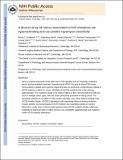| dc.contributor.author | Grabiner, Brian C. | |
| dc.contributor.author | Nardi, Valentina | |
| dc.contributor.author | Birsoy, Kivanc | |
| dc.contributor.author | Possemato, Richard | |
| dc.contributor.author | Shen, Kuang | |
| dc.contributor.author | Sinha, Sumi | |
| dc.contributor.author | Jordan, Alexander | |
| dc.contributor.author | Beck, Andrew H. | |
| dc.contributor.author | Sabatini, David | |
| dc.date.accessioned | 2015-04-23T17:15:49Z | |
| dc.date.available | 2015-04-23T17:15:49Z | |
| dc.date.issued | 2014-03 | |
| dc.date.submitted | 2014-03 | |
| dc.identifier.issn | 2159-8274 | |
| dc.identifier.issn | 2159-8290 | |
| dc.identifier.uri | http://hdl.handle.net/1721.1/96742 | |
| dc.description.abstract | Genes encoding components of the PI3K–AKT–mTOR signaling axis are frequently mutated in cancer, but few mutations have been characterized in MTOR, the gene encoding the mTOR kinase. Using publicly available tumor genome sequencing data, we generated a comprehensive catalog of mTOR pathway mutations in cancer, identifying 33 MTOR mutations that confer pathway hyperactivation. The mutations cluster in six distinct regions in the C-terminal half of mTOR and occur in multiple cancer types, with one cluster particularly prominent in kidney cancer. The activating mutations do not affect mTOR complex assembly, but a subset reduces binding to the mTOR inhibitor DEPTOR. mTOR complex 1 (mTORC1) signaling in cells expressing various activating mutations remains sensitive to pharmacologic mTOR inhibition, but is partially resistant to nutrient deprivation. Finally, cancer cell lines with hyperactivating MTOR mutations display heightened sensitivity to rapamycin both in culture and in vivo xenografts, suggesting that such mutations confer mTOR pathway dependency.
Significance: We report that a diverse set of cancer-associated MTOR mutations confer increased mTORC1/2 pathway activity and that cells harboring these mutations are highly sensitive to rapamycin in culture and in vivo. These findings are clinically relevant as the MTOR mutations characterized herein may serve as biomarkers for predicting tumor responses to mTOR inhibitors. | en_US |
| dc.description.sponsorship | Starr Cancer Consortium | en_US |
| dc.description.sponsorship | David H. Koch Institute for Integrative Cancer Research at MIT | en_US |
| dc.description.sponsorship | Alexander and Margaret Stewart Trust | en_US |
| dc.description.sponsorship | National Institutes of Health (U.S.) (Grant CA103866) | en_US |
| dc.description.sponsorship | National Institutes of Health (U.S.) (Grant CA129105) | en_US |
| dc.description.sponsorship | National Institutes of Health (U.S.) (Grant AI07389) | en_US |
| dc.language.iso | en_US | |
| dc.publisher | American Association for Cancer Research | en_US |
| dc.relation.isversionof | http://dx.doi.org/10.1158/2159-8290.cd-13-0929 | en_US |
| dc.rights | Creative Commons Attribution-Noncommercial-Share Alike | en_US |
| dc.rights.uri | http://creativecommons.org/licenses/by-nc-sa/4.0/ | en_US |
| dc.source | PMC | en_US |
| dc.title | A Diverse Array of Cancer-Associated MTOR Mutations Are Hyperactivating and Can Predict Rapamycin Sensitivity | en_US |
| dc.type | Article | en_US |
| dc.identifier.citation | Grabiner, B. C., V. Nardi, K. Birsoy, R. Possemato, K. Shen, S. Sinha, A. Jordan, A. H. Beck, and D. M. Sabatini. “A Diverse Array of Cancer-Associated MTOR Mutations Are Hyperactivating and Can Predict Rapamycin Sensitivity.” Cancer Discovery 4, no. 5 (March 14, 2014): 554–563. | en_US |
| dc.contributor.department | Massachusetts Institute of Technology. Department of Biology | en_US |
| dc.contributor.department | Whitehead Institute for Biomedical Research | en_US |
| dc.contributor.department | Koch Institute for Integrative Cancer Research at MIT | en_US |
| dc.contributor.mitauthor | Sabatini, David M. | en_US |
| dc.relation.journal | Cancer Discovery | en_US |
| dc.eprint.version | Author's final manuscript | en_US |
| dc.type.uri | http://purl.org/eprint/type/JournalArticle | en_US |
| eprint.status | http://purl.org/eprint/status/PeerReviewed | en_US |
| dspace.orderedauthors | Grabiner, B. C.; Nardi, V.; Birsoy, K.; Possemato, R.; Shen, K.; Sinha, S.; Jordan, A.; Beck, A. H.; Sabatini, D. M. | en_US |
| dc.identifier.orcid | https://orcid.org/0000-0002-1446-7256 | |
| mit.license | OPEN_ACCESS_POLICY | en_US |
| mit.metadata.status | Complete | |
